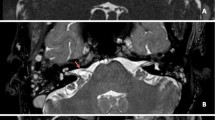Abstract
In this study, we aimed to assess anatomical relationship between the anterior inferior cerebellar artery (AICA) and cochleovestibular nerve (CNV) in patients with non-specific cochleovestibular symptoms using magnetic resonance imaging (MRI). One-hundred and forty patients with non-specific neuro-otologic symptoms were assessed using cranial and temporal MRI. Classification was performed according to four different types of anatomical relationship observed between the AICA and CVN. In type 1 (point compression), the AICA compresses only a limited portion of the CVN. In type 2 (longitudinal compression), the AICA approaches the CVN as both traverse parallel to each other. In type 3 (loop compression), the vascular loop of the AICA encircles the CVN. In type 4 (indentation), the AICA compresses the CVN so as to make an indentation in the nerve. The anatomical relationship between the CVN and AICA was encountered in 19 out of 140 (13.6%) patients (20 ears). The VCC was unilateral in 18 patients (94.7%) and bilateral in one patient (5.3%). There was no other vascular structure causing VCC to the CVN except for vertebral artery that was seen in 2 out of 140 patients (1.4%). These were unilateral cases. There were tinnitus, vertigo or dizziness, hearing loss, and both hearing loss and vertigo in 5 (25%), 13 (65%), 1 (5%) and 1 (5%) ears of 20 patients, respectively. There was no relationship between the cochleovestibular symptoms and type of compression (p>0.05). Neurovascular relationship between the CVN and AICA can be imaged properly using MR and MR based classification may help reporting this relationship in a standard way. Although, MR images can show the anatomical relationship accurately, diagnosis of vascular conflict should not be based on imaging findings alone.




Similar content being viewed by others
References
Applebaum EL, Valvassori GE (1984) Auditory and vestibular system findings in patients with vascular loops in the internal auditory canal. Ann Otol Rhinol Laryngol Suppl 112:63–70
Balansard ChF, Meller R, Bruzzo M, Chays A, Girard N, Magnan J (2003) Trigeminal neuralgia: results of microsurgical and endoscopic-assisted vascular decompression. Ann Otolaryngol Chir Cervicofac 120:330–337
Brackmann DE, Kesser BW, Day JD (2001) Microvascular decompression of the vestibulocochlear nerve for disabling positional vertigo: the House Ear Clinic experience. Otol Neurotol 22:882–887
Bird CR, Hasso AN, Drayer BP, Hinshaw DB Jr, Thompson JR (1985) The cerebellopontine angle and internal auditory canal: neurovascular anatomy on gas CT cisternograms. Radiology 154:667–670
Brunsteins DB, Ferreri AJ (1990) Microsurgical anatomy of VII and VIII cranial nerves and related arteries in the cerebellopontine angle. Surg Radiol Anat 12:259–265
Caces F, Chays A, Locatelli P, Bruzzo M, Epron JP, Fiacre E, Magnan J (1996) Neuro-vascular decompression in hemifacial spasm: anatomical, electrophysiological and therapeutic results apropos of 100 cases. Rev Laryngol Otol Rhinol (Bord) 117:347–351
De Carpentier J, Lynch N, Fisher A, Hughes D, Willatt D (1996) MR imaged neurovascular relationships at the cerebellopontine angle. Clin Otolaryngol 21:312–316
Girard N, Poncet M, Caces F, Tallon Y, Chays A, Martin-Bouyer P, Magnan J, Raybaud C (1997) Three-dimensional MRI of hemifacial spasm with surgical correlation. Neuroradiology 39:46–51
Kanzaki J, Ogawa K (1988) Internal auditory canal vascular loops and sensorineural hearing loss. Acta Otolaryngol Suppl 447:88–93
Kim HN, Kim YH, Park IY, Kim GR, Chung IH (1990) Variability of the surgical anatomy of the neurovascular complex of the cerebellopontine angle. Ann Otol Rhinol Laryngol 99:288–296
Levy EI, Scarrow AM, Jannetta PJ (2001) Microvascular decompression in the treatment of hypertension: review and update. Surg Neurol 55:2–10
Makins AE, Nikolopoulos TP, Ludman C, O’Donoghue GM (1998) Is there a correlation between vascular loops and unilateral auditory symptoms? Laryngoscope 108:1739–1742
Matsushima T, Rhoton AL Jr, de Oliveira E, Peace D (1983) Microsurgical anatomy of the veins of the posterior fossa. J Neurosurg 59:63–105
McDermott AL, Dutt SN, Irving RM, Pahor AL, Chavda SV (2003) Anterior inferior cerebellar artery syndrome: fact or fiction. Clin Otolaryngol 28:75–80
McLaughlin MR, Jannetta PJ, Clyde BL, Subach BR, Comey CH, Resnick DK (1999). Microvascular decompression of cranial nerves: lessons learned after 4400 operations. J Neurosurg 90:1–8
Oaknine GE (1981) Microsurgical anatomy of the arterial loops in the ponto-cerebellar angle and the internal acoustic meatus. In: Sarnii NI, Jannetta P (eds) The cranial nerves. Springer, Berlin Heidelberg New York, pp 378–390
Okamura T, Kurokawa Y, Ikeda N, Abiko S, Ideguchi M, Watanabe K, Kido T (2000) Microvascular decompression for cochlear symptoms. J Neurosurg 93:421–426
Parnes LS, Shimotakahara SG, Pelz D, Lee D, Fox AJ (1990) Vascular relationships of the vestibulocochlear nerve on magnetic resonance imaging. Am J Otol 11:278–281
Raybaud C, Girard N, Poncet M, Chays A, Caces F, Magnan J (1995) Current imaging of vasculo-neural conflicts in the cerebellopontine angle. Rev Laryngol Otol Rhinol (Bord) 116:99–103
Reisser C, Schuknecht HF (1991) The anterior inferior cerebellar artery in the internal auditory canal. Laryngoscope 101:761–766
Schwaber MK, Hall JW (1992) Cochleovestibular nerve compression syndrome I. Clinical features and audiovestibular findings. Laryngoscope 102:1020–1029
Wahlig JB, Kaufmann AM, Balzer J, Lovely TJ, Jannetta PJ (1999) Intraoperative loss of auditory function relieved by microvascular decompression of the cochlear nerve. Can J Neurol Sci 26:44–47
Author information
Authors and Affiliations
Corresponding author
Rights and permissions
About this article
Cite this article
Sirikci, A., Bayazit, Y., Ozer, E. et al. Magnetic resonance imaging based classification of anatomic relationship between the cochleovestibular nerve and anterior inferior cerebellar artery in patients with non-specific neuro-otologic symptoms. Surg Radiol Anat 27, 531–535 (2005). https://doi.org/10.1007/s00276-005-0015-6
Received:
Accepted:
Published:
Issue Date:
DOI: https://doi.org/10.1007/s00276-005-0015-6




